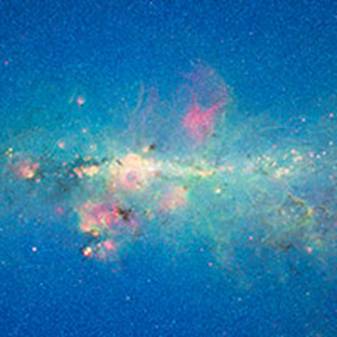07 June 2008

Credit: NASA/JPL-Caltech/University of Wisconsin
More than 800,000 snapshots from NASA's Spitzer Space Telescope (SST) have been stitched together to produce a new "coming of age" picture of stars in the inner region of our Milky Way Galaxy. The image covers an area of sky measuring 120 degrees by two degrees. It was unveiled recently at the 212th meeting of the American Astronomical Society (AAS) in St. Louis.
"This is the highest-resolution, largest, most sensitive infrared picture ever taken of our Milky Way," said Sean Carey of NASA's Spitzer Science Center at the California Institute of Technology, Caltech. Carey is principal investigator for one of two research teams responsible for the new picture. "Where previous surveys saw a single source of light, we now see a cluster of stars. With this data, we can learn how massive stars form, map galactic spiral arms and make a better estimate of our galaxy's star-formation rate," explained Carey.
Because Earth is located within our dusty, disk-shaped Galaxy, we have an edge-on view of our home Galaxy. To the unaided eye, the Milky Way is visible as a blurry, narrow band of light that stretches almost completely across the sky. With SST's dust-penetrating infrared eyes, astronomers peered 60,000 light-years away through the galactic plane, and glimpsed into the other side of the Galaxy.
Thus, a cosmic tapestry depicting a fantastic coming-of-age tale for stars was created. Areas hosting stellar embryos are identified by swaths of green, which are organic molecules, called polycyclic aromatic hydrocarbons (PAHs), illuminated by light from nearby newborn stars. On Earth, PAHs are found in automobile exhaust and charred barbeque grills, essentially anywhere carbon molecules are burned incompletely.
Extremely young stars shine as yellow and red dots, while the blue specks scattered throughout the photograph are individual older Milky Way stars. The red wispy structures highlight cosmic dust. The bluish-white haze in the middle two panels is starlight from the galaxy's older stellar population. A closer, careful inspection of the image also reveals the dusty remnants of dying and dead stars as translucent orange spheres. This infrared composite incorporates observations from two Spitzer instruments.
"With these Spitzer data, we've been able to catalogue more than 100 million stars," said Edward Churchwell of the University of Wisconsin, at Madison. Churchwell is principal investigator of one of the teams.
"This picture shows us that our Milky Way Galaxy is a crowded and dynamic place. We have a lot to learn. I've definitely found a lot of things in this map that I didn't expect to see," added Carey.
Further Reading
Spitzer Captures Stellar Coming of Age in Our Galaxy
http://www.spitzer.caltech.edu/Media/releases/ssc2008-11/release.shtml
Infrared Observatory Pictures a Shining Cosmic Opal
../home/NewsDetail.aspx?Find=xjiC7GYwYy%2bSUm016V60DA%3d%3d
Aymen Mohamed Ibrahem
Senior Astronomy Specialist